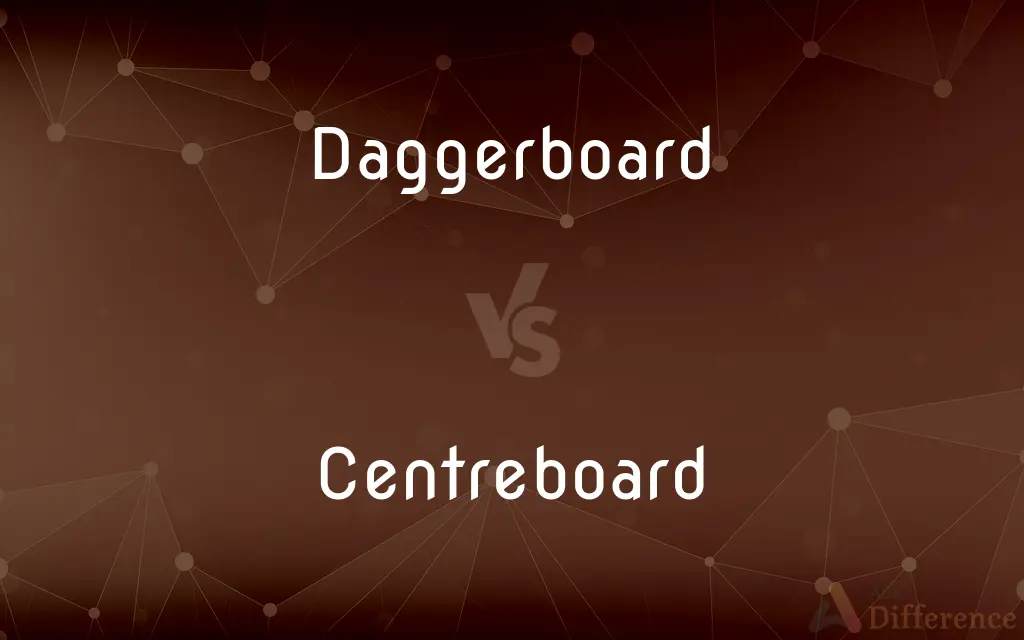Daggerboard vs. Centreboard — What's the Difference?
Edited by Tayyaba Rehman — By Fiza Rafique — Updated on April 8, 2024
Daggerboards are vertically oriented and lift out of the water, providing stability and control, while centreboards pivot upwards, adapting to varying depths and reducing grounding risk.

Difference Between Daggerboard and Centreboard
Table of Contents
ADVERTISEMENT
Key Differences
Daggerboards are fixed in a vertical position and are directly lifted out of the hull when not needed, commonly used in smaller sailboats. They are designed to provide maximum lateral resistance and stability, allowing for efficient upwind sailing. On the other hand, centreboards, which are also used to prevent leeway and improve upwind performance, are mounted on a pivot and can be raised or lowered as needed, making them suitable for sailing in waters of varying depth.
While daggerboards offer simplicity and efficiency in flat waters, their fixed position means they can be less adaptable to sudden changes in water depth, making them more susceptible to damage in shallow waters. Centreboards, however, can be partially or fully retracted, reducing the risk of grounding and allowing for more versatile sailing in coastal areas and estuaries.
In terms of performance, daggerboards generally provide better upwind capabilities due to their deeper reach and fixed position, which minimizes sideways slippage. Centreboards, while still effective upwind, may offer slightly less resistance and stability than daggerboards but compensate with their adaptability and reduced risk of damage.
Installation and maintenance differ between the two. Daggerboards are typically easier to install and maintain due to their simpler design. Centreboards, with their moving parts and mechanisms for raising and lowering, can require more maintenance to ensure smooth operation and to prevent wear and tear.
The choice between a daggerboard and a centreboard often comes down to the type of sailing and the waters navigated. Daggerboards are preferred for performance sailing in open waters, where depth is consistent and grounding is less of a concern. Centreboards are favored for recreational sailing in varied and shallower waters, where flexibility and adaptability are key.
ADVERTISEMENT
Comparison Chart
Orientation
Vertical
Pivots vertically
Adjustability
Lifts out of the water
Raises and lowers on a pivot
Suitability
Flat, open waters
Varied depths, coastal areas
Risk of Grounding
Higher in shallow waters
Reduced risk
Performance
Better upwind capability
Slightly less efficient upwind
Maintenance
Simpler, due to lack of moving parts
Requires more, due to moving parts
Compare with Definitions
Daggerboard
Suitable for flat, open waters.
The racing dinghy used a daggerboard for optimal performance on the lake.
Centreboard
A pivoting board that can be raised or lowered.
The sailor adjusted the centreboard depth to suit the changing water conditions.
Daggerboard
A vertically oriented board used for stability in sailboats.
The sailor lifted the daggerboard as he approached the shallow beach.
Centreboard
Can be partially retracted to prevent grounding.
Approaching the shore, the sailor partially raised the centreboard.
Daggerboard
Provides lateral resistance to prevent drifting.
With the daggerboard down, the sailboat could sail closer to the wind.
Centreboard
Allows for adaptability in various water depths.
The centreboard's design made it ideal for navigating both shallow and deep waters.
Daggerboard
Requires lifting for depth adjustment.
As the water depth decreased, the sailor had to lift the daggerboard manually.
Centreboard
Requires maintenance of its moving parts.
Regular checks ensured the centreboard mechanism remained functional.
Daggerboard
Simple in design and operation.
The small catamaran had a straightforward daggerboard system.
Centreboard
Provides stability and prevents leeway.
The centreboard helped maintain the sailboat's course against the wind.
Daggerboard
A daggerboard is a retractable centreboard used by various sailing craft. While other types of centreboard may pivot to retract, a daggerboard slides in a casing.
Centreboard
A centreboard or centerboard (US) is a retractable keel which pivots out of a slot in the hull of a sailboat, known as a centreboard trunk (UK) or centerboard case (US). The retractability allows the centreboard to be raised to operate in shallow waters, to move the centre of lateral resistance (offsetting changes to the sailplan that move the centre of effort aft), to reduce drag when the full area of the centreboard is not needed, or when removing the boat from the water, as when trailering.
Daggerboard
(nautical) A retractable centreboard that slides out to act as a keel.
Centreboard
The adjustable keel on a small yacht or dinghy that acts, among other things, as ballast and to counteract the sideways force of the wind.
Daggerboard
A removable centerboard on a small sailboat that can be lowered into the water to serve as a keel
Centreboard
Same as centerboard.
Centreboard
A retractable fin keel used on sailboats to prevent drifting to leeward
Common Curiosities
Why would a sailor choose a centreboard over a daggerboard?
A sailor might prefer a centreboard for sailing in areas where water depth varies significantly, offering the flexibility to adjust the board's depth as needed.
Can a daggerboard be adjusted while sailing?
Yes, a daggerboard can be lifted out of the water to adjust for depth but does not offer fine-tuned adjustments like a centreboard.
Is one better than the other for racing?
Daggerboards are often preferred in racing for their efficient upwind performance in consistent water depths, while centreboards might be chosen for versatility in varied conditions.
What maintenance is required for these boards?
Daggerboards require minimal maintenance, mainly around the slot's sealing to prevent water ingress. Centreboards need more attention, including pivot mechanisms and the casing to ensure smooth operation.
What happens if a daggerboard or centreboard is damaged?
Damage can significantly affect the boat's performance, particularly its ability to sail upwind. Repairs or replacements are necessary to restore functionality.
How does a centreboard pivot?
A centreboard pivots around a pin or bolt at its forward end, allowing it to be raised or lowered into the water.
Can centreboards be used in shallow water?
Yes, centreboards are particularly advantageous in shallow waters because they can be raised to minimize the risk of grounding.
How do you know when to raise or lower a centreboard?
This is determined by the water depth, the boat's speed, and the angle to the wind. Lowering the board improves upwind performance, while raising it is beneficial in shallow waters or when speed is not a priority.
What is the main purpose of a daggerboard or centreboard?
Both are used to provide lateral resistance against the water, preventing the boat from drifting sideways and improving upwind sailing performance.
How do daggerboards and centreboards affect a boat's performance?
Both improve a boat's ability to sail upwind by providing lateral resistance. Daggerboards may offer superior upwind performance, but centreboards offer more versatility in changing conditions.
Why are daggerboards less common in larger boats?
Larger boats often require a fixed keel for structural support and ballast, making daggerboards less practical due to their size and the complexity of lifting them.
Can a centreboard replace a keel?
Centreboards serve a similar purpose as keels in providing lateral resistance but are more adaptable. However, they do not provide as much ballast and structural support as fixed keels.
Are there boats that use both daggerboards and centreboards?
Most boats are designed to use one or the other, based on the intended use and performance characteristics of the boat.
Do daggerboards and centreboards affect the speed of a sailboat?
Yes, by reducing sideways drift and improving directional stability, they can enhance a boat's speed, especially when sailing upwind.
Is it possible to sail without a daggerboard or centreboard?
While possible, it's much harder to control the boat's direction and sail efficiently upwind without the lateral resistance these boards provide.
Share Your Discovery

Previous Comparison
Amazon vs. Flipkart
Next Comparison
Salesite vs. IodineAuthor Spotlight
Written by
Fiza RafiqueFiza Rafique is a skilled content writer at AskDifference.com, where she meticulously refines and enhances written pieces. Drawing from her vast editorial expertise, Fiza ensures clarity, accuracy, and precision in every article. Passionate about language, she continually seeks to elevate the quality of content for readers worldwide.
Edited by
Tayyaba RehmanTayyaba Rehman is a distinguished writer, currently serving as a primary contributor to askdifference.com. As a researcher in semantics and etymology, Tayyaba's passion for the complexity of languages and their distinctions has found a perfect home on the platform. Tayyaba delves into the intricacies of language, distinguishing between commonly confused words and phrases, thereby providing clarity for readers worldwide.















































